|
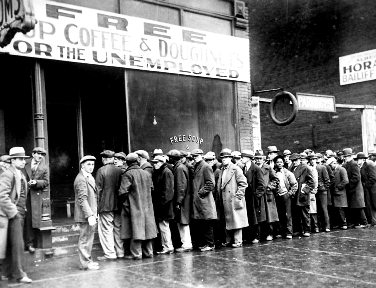
Great Depression Poverty - Soup Kitchen
|
Great Depression Poverty Facts: Fast Fact Sheet
Fast, fun facts and Frequently Asked Questions (FAQ's)
about the Great Depression Poverty.
What was the cause of Great Depression Poverty? The
cause of Great Depression Poverty included
mass unemployment, high levels of debt, loss
of savings as a result of the Wall Street
Crash, bankruptcies and foreclosures and
homelessness
What was the Great Depression Poverty Line? The
definition of the Great Depression Poverty
Line was when the level of deprivation
became heavily out of line with what were
considered the general living standards of
Americans. A reasonable average weekly wage
of $50 fell to $22.
What was the Great Depression Poverty
Cycle?
The Great Depression Poverty cycle was the
apparently endless continuation of poverty
triggered by a chain of events such as
unemployment - homelessness - inadequate
housing - hunger - family break-up -
exclusion from from ordinary living patterns
and activities - bad health and indications
of a bleak future.
Great Depression Poverty
Facts for kids
The following fact
sheet contains interesting facts and information on Great Depression Poverty.
This article provides answers to the question "What is poverty?"
providing examples of poverty during the Great Depression of the
1930s.
Facts
about Great Depression Poverty for kids
Great Depression Poverty Fact 1:
During the 1930s people fell into the Poverty trap. The
Poverty Trap can be defined as a spiraling mechanism
that forces people to remain poor and is so binding that
poor people are prevented from taking an acceptable
means of escape.
Great Depression Poverty Fact
2: The Great
Depression began with the 1929 Wall Street Crash.
Between 3 to 4 million Middle Class Americans (about 10%
of US households) had invested in the stock market
taking out margin loans and using their life savings.
Many other Americans had purchased expensive products,
like automobiles, on easy credit terms. These factors
had resulted in high levels of debt.
Great Depression Poverty Fact 3:
There was an uneven distribution of
income and lower class, poor Americans (about 60%
of the population) had been suffering even
before the Great Depression hit America.
Great Depression Poverty Fact
4: When the Great
Depression began in 1929, there were already nearly 18
million elderly and disabled people and single mothers
with children who were already living at a basic
subsistence level in America. Local state governments
and charities provided basic assistance to people in
need.
Great Depression Poverty Fact
5: There were many small,
unregulated banks in America in the 1920s who had also invested
their depositors money in the stock market. When the crash came they
were unable to respond to the withdrawal requests of their
customers. There were runs on the banks. Over 3000 banks went
bankrupt. The entire American banking system reached the brink of
collapse. When a bank collapsed its customers lost all of their
savings - and there was nothing they could do about it.
Great Depression Poverty Fact
6: Over 20,000 companies went bankrupt and closed. Lack of orders from these businesses
resulted in more closures and unemployment. Firms that were able to
survive made drastic pay cuts to keep companies afloat.
Great Depression Poverty Fact
7: Industrial
production dropped by 45% between 1929 and 1932. There
was a massive decline in American exports to Europe.
Exports fell from $2,341 million in 1929 to $784 million
in 1932.
Great Depression Poverty Fact
8: People were laid off work and their were no
opportunities for new employment. And there were few
government welfare systems before 1935.
Great Depression Poverty Fact
9: There was no
government financed "safety net" of welfare or relief
programs to keep Americans from falling into poverty. The levels of debt effected the
ability of many Americans to survive the effects of the
Great Depression. The number of suicides jumped to a
startling rate of 18.9 per 100,000 in 1929, the year of the Wall
Street crash.
Great Depression Poverty Fact
10: African Americans
were the first people to be laid off and they suffered
an unemployment rate that was initially double that of
white Americans. By 1932, the district of Harlem in New
York had an unemployment rate of 50%.
Great Depression Poverty Fact 11:
On top of all of these
terrible events a devastating drought hit the farmers in the
prairies states of America and the soil turned to dust.
Terrifying dust storms
destroying 100 million acres of land in the 'Dust
Bowl'.
Three million impoverished
farmers became unemployed and many families became homeless.
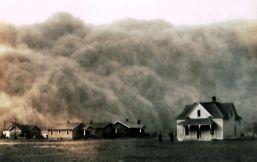
Great Depression Poverty Fact 12:
By 1932 a total of 12 million
Americans, about 25% of the normal labor force, had become
unemployed with over 12,000 additional people being laid off every
single day.
Continued...
Facts
about Great Depression Poverty for kids: The Poverty Cycle and
Poverty Trap
Facts
about the Great Depression Poverty for kids
The following fact
sheet continues with facts about Great Depression Poverty. This
article provides answers to the question "What is poverty?"
providing answers, examples and reasons.
Facts
about Great Depression Poverty for kids
Great Depression Poverty Fact 13:
State governments were unable
to respond to the plight of desperate Americans and charities could
no longer provide even minimum assistance for all those in need.
Great Depression Poverty Fact 14:
A vast number of
Americans were caught in the poverty trap in the 1930s and began to
experience the devastating chain of events referred to
as the poverty cycle.
Great Depression Poverty Fact 15:
Unemployment
triggered the poverty cycle. Men searched for jobs where
they lived but there were none to be had. Proud men and
their families had to join 'Bread Lines' or 'Soup
Kitchens' to stave off hunger. They had no alternative
but to leave their families in search of employment in
different parts of the country.
Great Depression Poverty Fact 16:
Desperate, hungry
and impoverished people had no option but to go to 'Soup
Kitchens', established by charities where food, mostly
soup and bread, was served to the hungry. Soup kitchens
provided food as many as 3000 hungry people every day
serving breakfast, lunch and dinner. The Soup kitchens
were set up in churches or any places suitable as
service centers. In summer they were set up outdoors.
The famous gangster Al Capone strengthened his image as
a 'Modern day Robin Hood' by financing a Soup Kitchen.
In 1932 President Hoover gave $4 million to the states
to open soup kitchens.
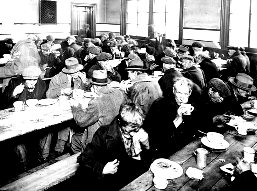
Great Depression Poverty Fact 17:
The 'Bread Lines'
were lines of people who were shamed into accepting free
handouts of food, notably bread. (At the time a loaf of
bread cost a nickel). Bread lines became a common sight
in most cities during the 1930s. There were so many poverty stricken
people that the Bread Lines sometimes stretched over
several blocks.
Great Depression Poverty Fact 18:
The despair of the
Breadlines was reflected in the lyrics of 1932 song by
Bing Crosby "Brother, Can You Spare a Dime?". The words
convey memories of the achievements of a man who had
worked all his life and wonders "Why should I be
standing in line, just waiting for bread?".
Great Depression Poverty Fact 19:
Many unemployed
men felt they were a burden on their families consuming
the scant food rations that were available. Men and a
large number young boys became hobos during the 1930s, searching for jobs anywhere in the country.
The easiest way to travel across the country was by
train and hobos would try to get a free ride on open
boxcars or in freight trains to every new destination.
Shantytowns, called 'Hobo Jungles' sprang up by most
city railroad stations. Between 1 - 2 million people
traveled the country desperately looking for work.
Signs saying 'No Men Wanted' were displayed everywhere.
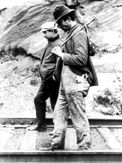
Great Depression Poverty Fact
20: Another indicator
of poverty was lack of education. The young boys who
became hobos never attended school and did not learn to
read and were therefore severely deprived of education.
In many towns teachers were laid off work resulting in
school closures or short school hours.
Great Depression Poverty Fact
21: Many people could not afford to buy
newspapers, and if they had no access to a radio, were
considered to be severely deprived of information
Great Depression Poverty Fact
22: Families broke up.
The lack of secure full-time employment, the need to
search across the country for jobs and the high levels
of stress all contributed to family breakdowns and the
resulting high levels of depression and despair all
formed part of the poverty cycle.
Great Depression Poverty Fact
23: People were
evicted from their homes, separated from friends and
neighbors and families were excluded from normal living
patterns and activities. Others squeezed in the homes of
relatives, living in hugely overcrowded conditions.
Great Depression Poverty Fact
24: The effects of
poverty in the 1930s led to feelings of shame, low self-esteem and
despair. People were driven to take desperate measures
and the crime rate in the Great Depression increased.
People became wary of strangers and were less likely to
offer help to strangers.
Great Depression Poverty Fact
25: The condition of
'absolute poverty' has been described as "a condition
characterized by severe deprivation of basic human
needs, including food, safe drinking water, sanitation
facilities, health, shelter, education and information".
Great Depression Poverty Fact
26: The Bread Lines
and Soup Kitchens illustrate the level of food
deprivation. The lack of education and information has
also been described but the greatest indicator of
poverty is the living conditions thrusted upon people as
a result of homelessness.
Great Depression Poverty Fact
27: Homeless people
were forced to live in Shanty towns, nicknamed Hoovervilles.
Refer to
Shantytowns and
Hoovervilles. Shanty towns consisted of makeshift shacks or tents were
set up on unused or public lands. These people were
forced to live in absolute poverty.
● Floors were
often made of dirt or mud
● Access to safe
drinking water was limited and only available from
rivers and ponds
● There were no
adequate sanitation facilities - latrines were dug
in ditches
● Tents and
makeshift shacks provided inadequate shelter
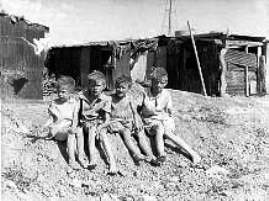
Great Depression Poverty Fact
28: Nearly 50% of
children were deprived of adequate food, clothing, shelter,
education or medical
care.
Great Depression Poverty Fact
29: Americans living
in such primitive conditions were subject to many health
problems. There was no easy access to health care.
Inadequate sanitation, lack of clean drinking water,
lack of food and poor nutrition lead to a variety of
diseases and illnesses such as rickets, influenza,
pneumonia, tuberculosis, diphtheria, skin diseases and
diarrhea.
Great Depression Poverty Fact
30: People without
access to medical facilities were unable to easily fight
off illness and disease. At least 33% of deaths were due
to poverty-related causes.
Great Depression Poverty Fact
31: Growing discontent
resulted in violent riots and protests such as hunger
marches in the 1930s. The 'Dearborn Hunger March', aka the Ford
Hunger March, that started in Detroit and ended in
Dearborn, Michigan in March 1932 led to deaths and
injuries of unemployed, poverty-stricken protestors.
The
Bonus Army was a
demonstration and hunger march by WW1 military veterans
who marched to Washington to lobby congress for early
payment of veterans’ bonuses. The plea was denied. The
Bonus Army were evicted from their camps by the heavy
handed treatment of the US Army under Douglas MacArthur.
Over 1000 people suffered
from tear gas inhalation, there were over
one hundred injuries and four people died. The camps
were burned to the ground.
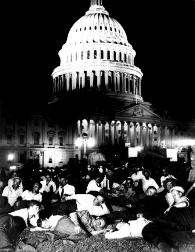
Great Depression Poverty Fact
32: Great Depression
Poverty was relieved to some extent by the welfare and
relief programs established in President Roosevelt's New
Deal. This most devastating period in American history
was brought to and end by yet another disaster - World
War Two. Refer to
US
Mobilization for WW2.
Facts
about the Poverty Cycle and
the Poverty Trap for kids
Facts
about
Great Depression Poverty
for kids
For visitors interested in the history of
the Great Depression refer to the following articles:
Great Depression Poverty - President Herbert Hoover Video
The article on the Great Depression Poverty provides detailed facts and a summary of one of the important events during his presidential term in office. The following
Herbert Hoover video will
give you additional important facts and dates about the political events experienced by the 31st American President whose presidency spanned from March 4, 1929 to March 4, 1933.
Great Depression Poverty: "What is
Poverty?"
●
Interesting Facts about Great Depression Poverty for kids and schools
●
Summary of the Great Depression Poverty in US history
●
The Great Depression Poverty, a major
event in US history
●
Poverty Cycle - Poverty Trap - Poverty Level
●
Fast, fun facts about Poverty in the Great Depression
●
Foreign & Domestic
policies of President Herbert Hoover
●
Herbert Hoover Presidency and
Great Depression Poverty for schools,
homework, kids and children |